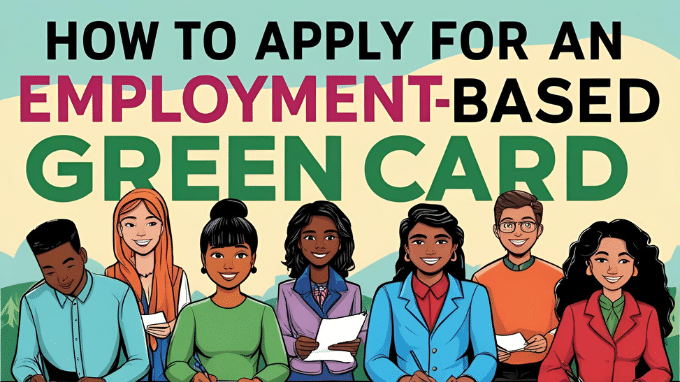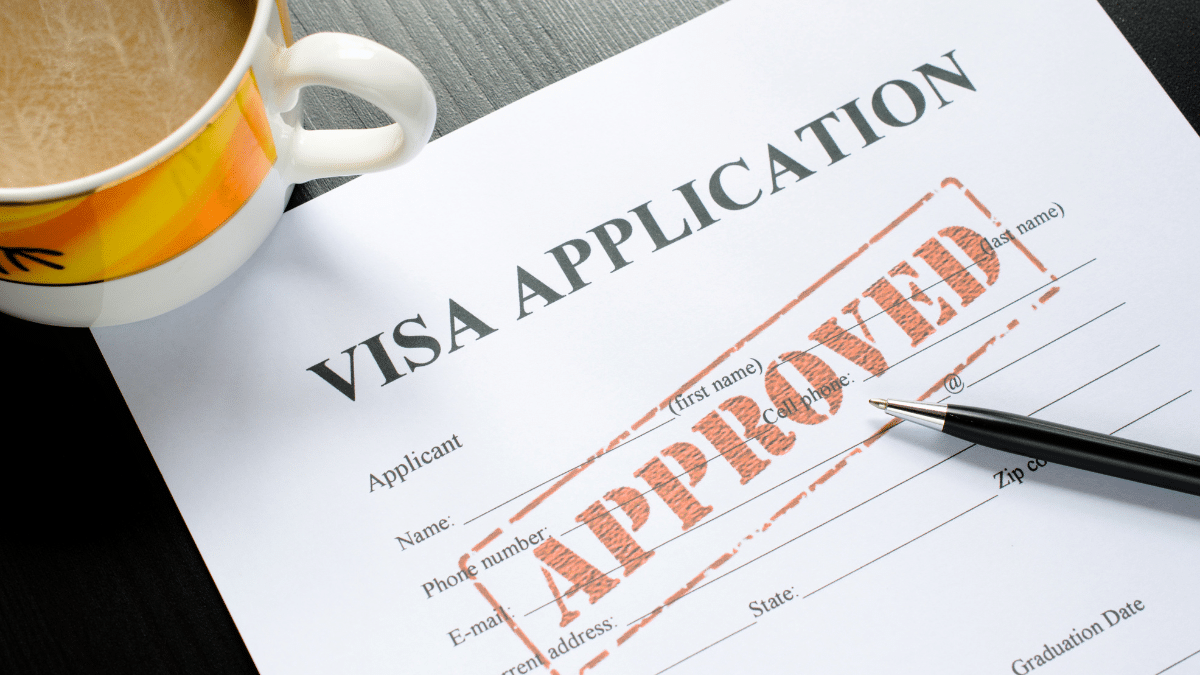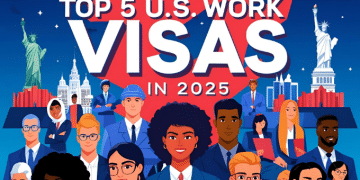How to Apply for an Employment-Based Green Card

If you’re a foreign professional who wants to live and work in the United States permanently, applying for an employment-based green card is an essential step in achieving your American dream. The job market in the United States offers plenty of opportunities in a variety of industries, such as technology, healthcare, education, and engineering.
But navigating the U.S. immigration system can be intimidating, especially when you have to deal with eligibility requirements, complicated forms, and evolving immigration laws. In order to make the application process easier to understand and follow, we have broken it down into a clear, step-by-step guide.
Whether you are currently on an H1B visa, on OPT after graduation, or seeking your first job offer in the United States, this guide will help you make informed decisions and confidently pursue permanent residency.
What Is an Employment-Based Green Card?

With an employment-based green card, non-citizens of the United States are allowed to live and work there permanently. Unlike temporary work visas (such as the H1B visa), a green card grants permanent resident status and opens the door to eventual U.S. citizenship.
Unlike the temporary work visas that many American professionals rely on, green cards offer permanent residency and more flexibility in changing jobs or employers.
Key Benefits:
- Permanent residency status
- Freedom to switch jobs or employers
- Eligibility for U.S. citizenship after five years
- Access to certain federal benefits
Main Categories of Employment-Based Green Cards:
EB-1: Priority Workers
Who qualifies:
- People with exceptional talent in the arts, sciences, business, education, or sports
- Outstanding researchers and instructors
- Certain managers and executives from multinational corporations
Key requirements:
- Must show sustained national or international acclaim
Provide extensive documentation (e.g., major awards, published work, media coverage, leadership roles)
Advantages:
- No labor certification usually required
- Faster processing times due to lower demand compared to other green card categories
Read next: H1B vs L1 Visa: Key Differences, Requirements & Which Is Better in 2025
EB-2: Professionals with Advanced Degrees or Exceptional Ability
Who qualifies:
- Professionals with a master’s degree or higher
- Individuals with exceptional ability in sciences, arts, or business
- Applicants eligible for a National Interest Waiver (NIW)
Key requirements:
- Typically requires a job offer and PERM labor certification
- NIW applicants can self-petition if their work benefits the national interest
- Must provide documentation such as academic credentials, reference letters, or published work
Advantages:
- NIW option bypasses employer sponsorship
- Generally faster than EB-3 if not subject to country-based backlog
EB-3: Skilled Workers, Professionals, and Other Workers
Who qualifies:
- Skilled workers with at least 2 years of training or experience
- Professionals with a bachelor’s degree or foreign equivalent
- Other workers performing unskilled labor that requires less than 2 years of training
Key requirements:
- Must have a permanent, full-time job offer
- Requires PERM labor certification
- Employer must demonstrate there are no qualified U.S. workers for the position
Challenges:
- Faces longer wait times, especially for applicants from countries like India or China
- Broader scope leads to greater demand and backlogs
EB-4: Special Immigrants
Who qualifies:
Religious workers
- Employees of U.S. embassies and consulates abroad
- Retired employees of international organizations
- Certain Afghan and Iraqi nationals who worked with the U.S. government
- Members of the U.S. Armed Forces
Key requirements:
- Generally requires employer sponsorship
- Application procedures vary by subcategory
Notes:
- A niche but important category
- Offers vital pathways for those who have served U.S. interests abroad or in sensitive roles
EB-5: Immigrant Investors
Who qualifies:
- Foreign nationals investing $1.05 million (or $800,000 in Targeted Employment Areas) in a U.S. business
- Must create or preserve at least 10 full-time jobs for U.S. workers
Key requirements:
- No job offer or labor certification needed
- Must prove a lawful source of funds and business plan viability
- Investment must be “at risk” and committed to a new commercial enterprise
Advantages:
- Self-sponsored green card option
- Appeals to high-net-worth individuals seeking permanent residency through job creation and capital investment
Step-by-Step: How to Apply for an Employment-Based Green Card
Step 1: Determine Your Eligibility
Before applying, understand which category (EB-1 to EB-5) best matches your background and qualifications.
Considerations:
- Do you hold an advanced degree?
Are you currently on a work visa in the USA, like an H1B? - Do you qualify for a National Interest Waiver?
Read next: Top 5 Work Visas for International Workers in 2025
Step 2: Employer Sponsorship or Self-Petition
Most employment-based green cards require an employer sponsor. However, EB-1 and EB-2 NIW applicants can self-petition.
Employer-Sponsored Path:
- Employer must file PERM Labor Certification
- Then submit Form I-140 (Immigrant Petition for Alien Worker)
Self-Petition Path (EB-1/NIW):
- Bypass employer requirement
- Must provide evidence of qualifications, impact, and merit
Step 3: PERM Labor Certification (If Required)
The PERM process ensures no qualified U.S. workers are available for the role you intend to fill.
Key Steps:
- Employer conducts recruitment campaign
- Files ETA Form 9089 with the Department of Labor
- Waits for approval before moving to the next stage
Step 4: File Form I-140
After PERM approval (if applicable), your employer or you (for self-petitions) will file Form I-140.
Documentation Needed:
- Proof of qualifications (degrees, experience)
- Job offer letter or employment contract
- Evidence of company’s ability to pay
Step 5: Priority Date and Visa Bulletin
Once the I-140 is filed, a priority date is established. Track this date in the Visa Bulletin published monthly by the U.S. Department of State.
Why It Matters:
- You can only proceed to the next step once your priority date is current
Step 6: File for Adjustment of Status (Form I-485) or Consular Processing
Depending on your location:
- In the U.S.: File Form I-485 (Adjustment of Status)
- Outside the U.S.: Use Consular Processing through a U.S. embassy or consulate
Documents Required:
- Medical examination report (Form I-693)
- Biometrics and background check
- Affidavit of Support (if applicable)
Special Considerations for OPT Students and H1B Visa Holders
For OPT Students:
- Start early by securing a job offer related to your degree
- Consider the STEM OPT Extension (24 months extra)
- Work with your employer on a transition plan to H1B or green card
For H1B Visa Holders:
- H1B visa is a dual intent visa, making it easier to apply for a green card
- Employers should begin the green card process by Year 2 or 3 of H1B to avoid status gaps
Common Challenges and How to Overcome Them
Delays in Processing Times
The USCIS receives thousands of green card petitions annually, leading to inevitable backlogs.
How to Handle It:
- Regularly check current timelines using USCIS Processing Times
- Opt for premium processing of Form I-140, which can reduce wait time to 15 calendar days (fee applies)
- Submit complete and error-free applications to avoid Request for Evidence (RFE) delays
- Sign up for case updates and processing notifications via the USCIS portal
Changing Employers Mid-Process
Changing jobs during the green card process—especially after PERM and I-140 approval—requires strategic planning.
Risks and Solutions:
- Before I-140 approval: You’ll likely need to restart the PERM and I-140 with the new employer
- After I-140 approval and 180 days: Under AC21 portability rules, you may switch to a similar role with another employer without resetting the process
- Always consult an immigration attorney to evaluate timing and job description comparisons
Visa Bulletin Retrogression
Applicants from countries with high demand (e.g., India, China) often face retrogression—where the priority date moves backward.
Strategies to Mitigate Impact:
- Track the Visa Bulletin monthly
- File Form I-485 as soon as the date becomes current, even if it’s only briefly
- If eligible, explore the EB-2 or EB-1 categories to benefit from faster timelines
- Consider using cross-chargeability if your spouse was born in a country with less backlog
Tips for a Smooth Application
Work with a qualified immigration attorney
Hiring an experienced immigration attorney can be one of the most important investments in your green card journey.
An attorney helps you avoid common pitfalls, ensures timely and accurate filings, and stays on top of legal changes that may affect your eligibility.
They can also provide crucial strategic advice if your case is complex or involves changing employers.
Read next: How to Apply for an Employment-Based Green Card: Step-by-Step Guide (2025)
Gather complete documentation and keep digital copies
Throughout the green card process, you’ll be required to submit a variety of documents—educational transcripts, employment verification letters, tax records, and more.
Make it a habit to collect and organize these documents early. Maintaining both hard copies and digitized files in secure cloud storage will help you respond quickly to any USCIS requests or deadlines.
Maintain legal status in the U.S. throughout the process
It’s critical to maintain valid immigration status while your application is pending. Falling out of status can jeopardize your entire green card petition.
This means renewing your H1B or OPT on time, avoiding unauthorized work, and keeping your SEVIS record up to date if you’re a student.
If you’re unsure, consult with your immigration advisor or attorney to stay compliant.
Stay proactive: Track dates, deadlines, and changes in immigration law
The green card process is time-sensitive and often subject to change.
Use digital calendars or immigration tracking apps to stay on top of your priority date, visa bulletin updates, and document expiration dates.
Subscribe to email updates from USCIS and Department of State websites to stay informed about policy shifts that could impact your case.
U.S. Immigration Laws: What You Should Know
- U.S. immigration law is constantly evolving—new legislation may impact timelines and eligibility
- Monitor official sources like USCIS.gov and travel.state.gov
- Recent proposals may increase green card caps or streamline processes for STEM graduates
Take the First Step Toward Your American Dream
Applying for an employment-based green card is a significant milestone that opens the door to a future in the United States. By understanding the process, preparing the right documents, and staying informed about immigration laws, you set yourself up for success. Whether you’re starting from OPT, working on an H1B visa, or ready to self-petition under EB-1 or EB-2 NIW, your path to permanent residency is within reach.
Ready to start your green card journey? Consult with an immigration attorney today and begin building your future in the United States.





